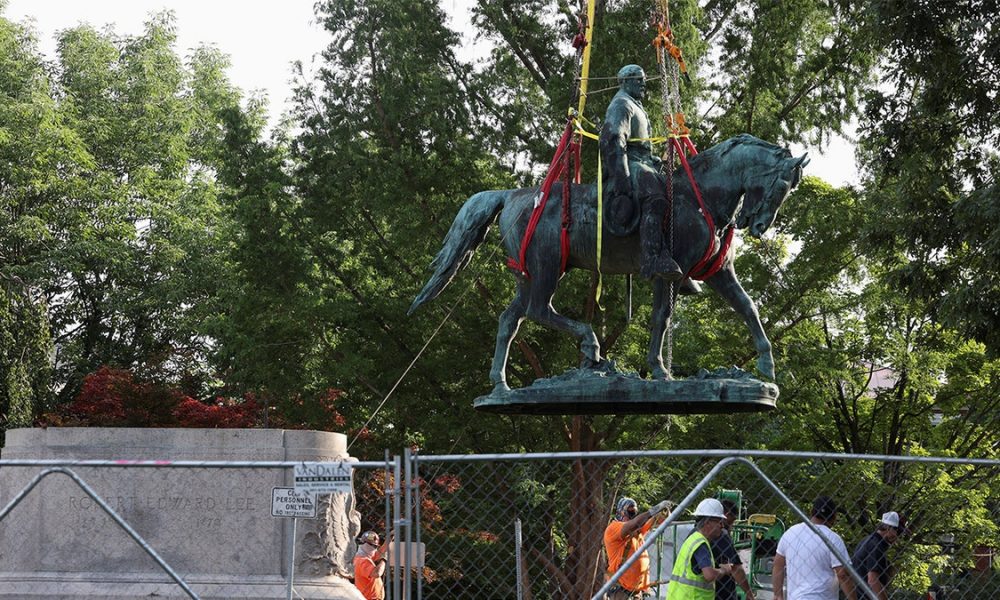People of color and allies in Charlottesville, Virginia, cheered as crew workers removed the Robert E. Lee and Thomas J. “Stonewell” Jackson statues that were the catalyst for a deadly white supremacist rally.
What We Know:
- In 2016, a Black high school student Zyahna Bryant petitioned for Lee’s statue to be removed and was approved by city councils for removal in 2017. Pro-monument organizations, such as the Virginia Division of the Sons of Confederate Veterans, filed a suit urging the city not to take the statues down. The division between those who wanted the statues removed and those who didn’t come to a boil the summer of 2017 during the “Unite the Right” rally.
- On August 11, 2017, neo-Nazis, white nationalists, and Ku Klux Klan members arrived in Charlottesville to protest the removal of the confederate statues. They walked across the University of Virginia campus with torches and chanted “Jews will not replace us” and ended up fighting against anti-racist counterprotesters. The next day they gathered near Lee’s statue for the rally and again fought against counterprotesters, which ended in the death of Heather Heyer, 32, and injuries to others. Neo-Nazi James Alex Fields Jr. drove through the counterprotesters, killing Heyer. Former President Donald Trump blamed both sides for the rally turning violent during a press conference. The state had to declare a state of emergency.
- Many believed the statues of the Generals held racial connotations, such as white supremacy, as they were constructed during the Jim Crow Era when Black Americans were having their rights taken away. Sterling Howell, a program coordinator for the Albemarle Charlottesville Historical Society, stated that they were created during “the height of lynchings in American history,” proving that Black people weren’t welcomed in the country. Jackson’s statue was built in an area that used to be a prominent Black neighborhood in the city. At the same time, events that celebrated Confederate veterans were held in Vinegar Hill, another affluent Black neighborhood.
This is not erasing history. This is correcting who we honor from history with public statues.
Who we honor from history is typically who we honor in the present.
The conservators of racism want us to honor the conservators of slavery. No more.https://t.co/YoDyIV1dkc
— Ibram X. Kendi (@DrIbram) July 10, 2021
- The increasing number of Black people being killed at the hands of police in America pushed the notion that Confederate monuments needed to be removed. According to a 2020 study by the Southern Poverty Law Center, “270 Confederate symbols have been removed over the past few years, with 1,600 remaining” in the country.
- States such as North Carolina, Texas, Florida, and Maryland have removed the most Confederate monuments and symbols since the aftermath of the Black Lives Matter movement protest of 2020. Nashville, Tennesse was able to remove the bust of Nathan Bedford Forrest, a Confederate Army general who was the first grand wizard of the KKK. Unfortunately, states such as Mississippi, Georgia, and West Virginia have ways to rid the states of racist symbols, with Georgia still having close to 200 located around the state.
- In an emergency meeting Saturday, city officials decided in a unanimous vote to remove the Meriwether Lewis and William Clark statue that featured Sacagawea, a Shoshone interpreter. Native Americans found the statue offensive, as it showcased Sacagawea as their little pet while the two explorers stood proudly. Dustina Abrhamson, a great-great-great niece of Sacagawea, told NPR that the statue made the Native American icon seem like a “coward.” Her mother, Rose Ann Abrhamson, said she wouldn’t mind seeing the statue being used as an educational tool.
“I feel that it should just be melted down. That’s my opinion. I feel that it’s entirely offensive and it should be obliterate, but if it can be utilized to give a message — to give a greater message — to educate the public, that would be an opportunity. So I’m very pleased with what is taking place, and it’s been a long road,” said Rose Ann Abrahamson.
- Nikuyah Walker, Charlottesville’s first Black female mayor, believes removing these statues is a step in the right direction. She stated that we are “one step closer to the goal of helping Charlottesville and America grapple with the sin of being willing to destroy Black people for economic gain.” A spokesperson for President Joe Biden tweeted that he is in agreement with the removal of the statutes and believes that “monuments to Confederate leaders belong in museums, not in public places.”
For now, the statues will be placed in a secure location while the city comes up with a more permanent plan. The stone bases of the statues will be removed at a later date.



